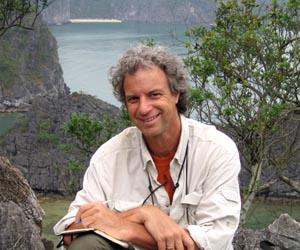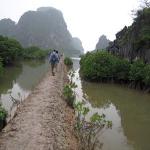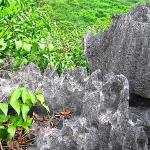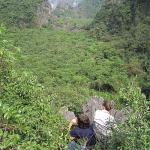Valley of the Langurs
* * *
CAT BA ISLAND, VIETNAM - "There are no guarantees," says Rosie. "That you will see even one langur the whole time you are on Cat Ba Island."
Sure, I nod. I understand. I get it - but I don't get it. True, it was a full four months before project director Rosie Stenke saw her first langur. But Sally Keith, the British volunteer, saw a group of seven her first day. Seacology director Duane Silverstein, on a three-day visit, saw one. And I'm convinced that I will, too, Rosie's caveat to the contrary notwithstanding.
Our starting point for the day's trek into langur territory will be the impressive shrimp and fish farm of another of Rosie's three first rank langur guardians. Mr. Tranh, who lost his right arm in a construction accident, may be the most respected individual working with Rosie's langur protection project. Tranh is 52, a commune leader, a successful businessman, and a former soldier. He has several important brothers, also a mark of high status.
Rosie, Sally, Hung (Rosie's assistant) and I meet at the national park headquarters at 6 a.m., and throttle off on 110 cc motor scooters to the harbor at Phu Long, on the island's northwest shore. There we meet Tranh, and climb aboard his noisy wooden motorboat. It takes a long hour to reach his remote shrimp and fish farm, navigating narrow, shallow channels that are impassible at low tide.
Many of the 366 islands in the Cat Ba archipelago were formerly connected by mangrove swamps, but shrimp and fish farming has changed that. We'll be visiting several sites on nearby Dong Cong island, possible haunts of the three female langurs who were marooned on Dong Cong when the mangroves were cut to build seafood farms. As part of her job, Sally (who holds a Master's degree in primate conservation from Oxford) will be returning to Dong Cong alone, for weeks at a time. She'll habituate the langurs to her presence, find out where they sleep, and help create a strategy for moving them back among the breeding groups on Cat Ba island itself.
Fish and shrimp farms - separated by long, narrow mud dams - link Tranh's compound with Dong Cong. We set off on foot, followed by barking dogs. Mr. Hung cuts us walking sticks, and we begin the precarious journey across the dikes. On either side lies deep, muddy water. The tide is still high, and the dams are broken in several places. We sink to our shins in wet, stinky mud, which tries with all its might to suck the sneakers off our feet. One break is patched with mud-covered planks; they're as slippery as greased glass. I move very slowly. One false step and I'll be in the soup: binoculars, notebooks, camera, and all.
Ang Coc means "Frog Valley." There are at least three Ang Cocs on Dong Cong, separated by ridges; the elusive langurs might be in any of them.
Part of the day's plan is to give newcomer volunteer Sally Keith (and me) a taste of jungle walking. As we leave the dike and begin our first ascent, Rosie hands us each a pair of leather gardeners' gloves. The limestone rocks, ancient coral reefs uplifted by seismic activity, bristle with points and edges so sharp they can be used to cut meat.
We reach a low perch overlooking Ang Coc 1, and spend 15 minutes scanning for signs of activity. Nothing. Off to the next. The valleys are separated by rocky notches, which we reach by thrashing through dry undergrowth, squishing between stray mangroves, tripping over long roots, and climbing up calcified reefs.
When we reach the overlook between the second and third valleys, Rosie sheds her daypack. This, she announces, is our best bet for seeing langurs.
It's difficult to find a perch. There are hundreds of stones, and not one of them has anything resembling a sit-able surface. Unless one has climbed over this limestone karst, wearing leather gloves and watching one's sneakers being shredded, one has no idea how sharp they really are. Visualize being a swami, and sitting on a bed of nails. Better still: visualize sitting on a bed of nails, without even being a swami.
Time passes. Fifteen minutes; an hour; two; three. There are loads of butterflies. Most of them have brilliant blue wings, dotted with white specks. (There are no frogs; I guess it's too early.) There are ants, lizards, and starlings. There are wasps the size of single-engine aircraft. I'm convinced that if we had been looking for any of these things they would of course be absent, and the jungle would be teeming with langurs.
At one point, there's hope. A hoarse call is heard from the jungle, near the top of a relatively nearby cliff. "Shhhh!" exclaims Rosie. "Langurs!" But it is a troupe of rhesus macaques, half a dozen that we can see, commanding the high ground. Though it's a treat to see any primate in the wild, this sighting contains a kernel of disappointment. The presence of these other monkeys makes it very unlikely that the three female langurs are nearby.
We continue to wait.
This, Rosie informs me, is what field research is all about: long hours sitting in the jungle, waiting to see something, or waiting to see something do something. "And always keeping your eyes and ears open," says Rosie. There's more: brushing off red ants, waving away mosquitoes, listening to the birds, watching butterflies. It's not bad, really. But one does hope to see something.
Three o'clock - the final window during which the primates might be active - comes and goes without a sign of the langurs.
"I'm about ready," I say, "to declare this a langur-free zone."
Rosie agrees; we have to return to Tranh's in time for an early dinner. Regretfully, we make our way back through the jungle, over the rocks, across the muddy dams. It's the first clear day I've seen in Vietnam, and the surrounding islets glow in the afternoon light.
"Where are you?" Rosie asks the invisible langurs, somewhere in the nearby jungle. "Are you up there, studying us?" More than once, she and her researchers have spent an entire day in an apparently fruitless search for the animals - only to pack up and find the langurs resting trees not fifty feet way, watching them. "Like television," she adds dryly.
As I writer, I crave such a flourish. How sweet it would be to end this story with a last-minute langur sighting: a golden head popping through the tree cover; a tail hanging from a high perch; a Busby Berkeley number with the langurs in top hats.
But there are only three langurs on Dong Cong: females, not gregarious males. The island may be small, but there's a lot of places to hide. My only hope, dear reader, is that if you ever visit Dong Cong in search of Cat Ba langurs, your success will be all the more sweet for my failure. But don't bet the farm on seeing anything. Bring plenty of water, insect repellent, and a Dostoevsky novel.
Alls' well that ends well. Mr. Tranh and his family have prepared an astonishing feast: crabs, giant prawns - "all organic," Hung translates - shrimp, fish, boiled greens, and fried oysters. There are gallons of "bee's nest wine," and Tranh offers one toast after another as I dip a steady procession of the oysters into Vietnamese hot sauce.
Tranh is my age; we were both 18 in 1972, during the Vietnam War. It is impolite, Rosie has told me, to bring up the war. Still, I am tempted to remark on how amazing this moment would have seemed to me when I was a teenager. In high school, my greatest fear was of being sent to this country. Yet here I am today, toasting to friendship and picking bees out of my wine.
I sense Tranh feels the same way. He looks at me with an expression of affection and respect - well aware, as am I, of Fate's strange hand.
The day ends with a long, dreamy ride in Tranh's motorboat, back to Phu Long in the pitch darkness. Constellations glow faintly overhead: Orion, and Sirius. We navigate a narrow channel, passing between the towering shadows of nearby isles as bioluminescence foams in our wake.
Tranh steers the boat with his good arm, shaking his head as Hung offers to hold a flashlight.
* * *
My final afternoon on Cat Ba island, Rosie and Hung hire a small motorboat at the local harbor on the far side of Cat Ba town. A gristly fisherman with a pockmarked face loads us in, and we motor off toward the fractal-shaped southern peninsulas raking into Cat Ba Bay.
"There is a group of seven langurs - a breeding group - living somewhere on one of the peninsulas," Rosie says. "They have a baby with them - the 64th Cat Ba langur - so they may not stray very far from where Sally saw them, last week."
On our way out, we pass a large settlement of floating homes, green and blue, each surrounded by broad nets and protected by business-minded dogs. Cat Ba's "floating population," as Rosie puts it, numbers more than 5,000. It's amazing to see these small, neat little houses floating on the surface of the bay, many with television aerials sprouting from their roofs. Most of the dogs turn a lazy eye as we pass; others bark menacingly, as if daring us to raid the nets in their charge.
Slowly, slowly (but noisily), we glide along the steep coastline of the peninsulas. Our boat engine, Rosie assures us, won't alarm the primates. We scan the forest with binoculars, hoping for a glimpse of a black body, or a golden head. Since I don't really know how to recognize what I'm looking for, everything dark and fuzzy looks like a potential langur.
Time passes, much as it did the previous day on Dong Cong. I'm suffused with a sense of futility. The jungle is so vast, and the langurs so small. The thought of seeing one at all is beginning to seem surreal, impossible. I've got a better chance of running into Naomi Watts on the minibus back to Hanoi.
Our only hope at this point is to beach the boat at a shrimp farmer's hut, and climb to a ridge overlooking one of the peninsula's central valleys. Rosie hands me my gloves. This ridge is very steep, almost vertical. Higher we climb, up the sharp stones, until we reach a place to rest. There's a breathtaking view of the little bay behind us, and of the valley to the west. It is mid-afternoon. A visual scan reveals nothing, and our arrival has excited no alarm calls.
As Rosie settles onto a perch I move a little higher on the ridge, looking for a place to sit. My footing is precarious, at best. Suddenly, the small block of limestone I've put my weight on shifts. I grip the surrounding rocks as the slab beneath my foot tumbles over.
When karst strikes karst, it makes a metallic ringing sound, like a tire iron hitting a fire hydrant. The clatter echoes across the valley - and I see a burst of activity in a distant tree. I swing my binoculars up, and croak to Rosie: "Langurs! At least three of them."
It takes her a minute to find them, but there they are: six in all, one of the females holding a bright orange baby across her shoulder. Rosie's hunch was right: with an infant in tow, the group hadn't strayed much during the past week. And though they are a fair distance away, we can see them clearly as they make their way across a nearly vertical cliff face, toward the shelter of a tree-lined gap.
We remain on the ridgeline for more than an hour, watching the group as they play, posture, and climb. Their pale yellow heads make them look like animated matchsticks. At one point the male leaves his harem, and prances across the far-off ridgeline, elegant in silhouette. Mostly, the langurs are just hanging out, being langurs. But every action - climbing, grooming, passing the baby from female to female (a very golden-maned langur thing to do) is exciting, and Rosie narrates for me with the enthusiasm of am announcer at a heavyweight bout.
"The juvenile female has the baby... she's passing it off! There goes the male... he's jumping from rock to rock... look at that tail! And here comes another juvenile. Is it a coincidence, or did the male run off to call him?"
At about 3:30, the primates disappear over the ridgeline. We wait about 15 minutes, then climb back down to our mooring. With luck, we can motor around the narrow peninsula, and catch them again, on the other side.
Now that I've seen the langurs, of course, anything else is gravy. True, they were too far away to photograph; it was kind of like seeing the Rolling Stones from the bleachers at Candlestick Park. But I'm not complaining.
"A good sighting," Rosie says as we climb back into the boat. "Not a great sighting, but a good sighting."
"Infinitely preferable," I reply, "to no sighting at all."
We soon reach the peninsula's flip side, and climb off the boat onto rocks covered with oyster shells so sharp they make the limestone edges look like dull spoons in comparison. Squatting down, we soon spy the langurs, huddled in a little knoll. We're on the main fishing route now. As we watch the monkeys, boat after boat passes behind us, each one filled with curious locals.
Rosie sits bolt upright. "This is just great," She declares. "Now everyone on the whole island who wants to hunt langurs will know exactly where to find them."
Hung, Rosie, and I look at each other. The irony is inescapable, and our only recourse clear.
"In that case," I say, "we'd better get out of here."
And we do.
* * * * *
 ThingsAsian
ThingsAsian



















